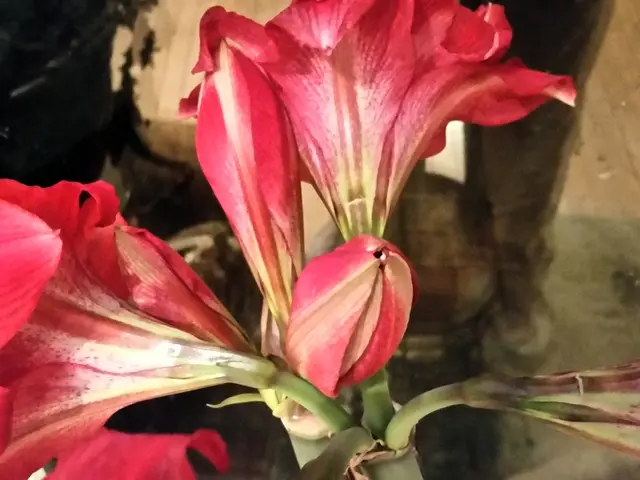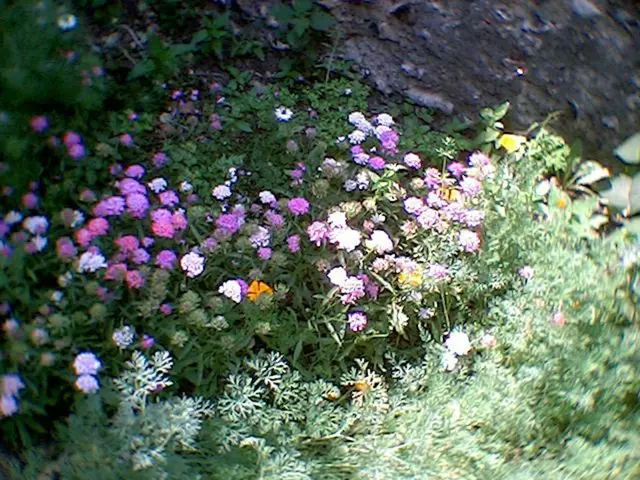Plants that Prosper Effortlessly in Poor Soil, Offering a Stunning Visual Appeal
struggles in gardens, it's worth noting that not every plant demands rich, fertile soil to thrive. Numerous stunning, low-maintenance plants actually perform better in challenging conditions. This gallery presents 25 of the best garden performers, each of which can flourish in poor soil with minimal attention.
1. Yarrow (Achillea millefolium)
Yarrow is a hardy perennial, characterized by feathery leaves and flat flower clusters. It effortlessly adapts to rocky or sandy soil and blooms in a variety of soft pastels, bold reds, or yellows. Ideal for full sun, this pest-resistant plant spreads easily with little assistance and is adored by pollinators. A perfect choice for borders or wildflower areas where maintenance is limited.
2. Black-Eyed Susan (Rudbeckia hirta)
These wildflowers, with bright yellow petals and dark centers, are easily recognizable and bring cheer to any space. Black-Eyed Susans bloom in poor, dry soil for multiple months and self-seed generously. Attracting butterflies and bees while withstanding heat and drought, they are perfect for borders, natural areas, or cottage-style gardens. Once established, they return annually with minimal help.
3. Sedum (Stonecrop)
A group of succulents, sedum particularly excels in dry, lean soil. Their fleshy leaves store water efficiently, ensuring they can endure drought with ease. Star-shaped flowers bloom in late summer and attract bees. Ideal for rock gardens, slopes, and containers, sedum thrives in poor conditions without much effort.
4. Coneflower (Echinacea purpurea)
Shining in dry, poor soil and full sun, coneflowers boast purple petals and cone-shaped centers that attract a variety of butterflies, bees, and birds. These perennials bloom from summer to fall, multiply on their own, and require minimal maintenance, making them ideal for wildlife-friendly landscapes.
5. Russian Sage (Perovskia atriplicifolia)
Russian Sage adds tall lavender-blue spikes and silvery leaves to any garden. Hardy, this plant thrives in dry soil and full sun with negligible fuss. Pest-proof and drought-tolerant, it grows upright and fills gaps beautifully. An excellent selection for dry, open beds.
6. Blanket Flower (Gaillardia)
Bold red and yellow daisy-like blooms decorate blanket flowers, which handle heat and poor soil without difficulty, making them ideal for xeriscaping. These long-bloomers attract pollinators and resist drought. Their bright colors effectively enhance low-maintenance beds. Once planted, they reliably keep going strong.
7. Butterfly Weed (Asclepias tuberosa)
Butterfly Weed thrives in sandy or rocky soil and requires full sun. Its vibrant orange blooms allure monarchs, bees, and other pollinators. This drought-tolerant plant tends to be slow to establish but lasts for years. It is best left undisturbed once planted. A striking and purposeful choice for wildflower gardens.
8. Bee Balm (Monarda)
Bee Balm displays bright, spiky blooms in red, pink, or purple, along with fragrant foliage. It adapts well to average or poor soil, spreads quickly, and covers bare spots. Hummingbirds, butterflies, and bees are drawn to it. Deer typically avoid it. A colorful plant that effortlessly fills out summer borders.
9. Coreopsis (Tickseed)
Coreopsis delights with sunny yellow flowers that last from early summer to fall. Adaptable to sandy, poor soil, and dry conditions, this perennial attracts bees and butterflies. It is easy to grow, cheerful, and self-seeds gracefully, making it suitable for large beds or wild borders.
10. Daylily (Hemerocallis)
Daylilies deliver colorful blooms in various shades that demand little care. Ideal for dry, lean soil, they repeatedly bloom throughout the summer. Each flower lasts only a day, but the plant continuously produces them. They are dependable and hardy in many climates, making them great for borders and neglected spots.
11. Lamb’s Ear (Stachys byzantina)
Lamb’s Ear forms silvery mats of soft, fuzzy leaves which maintain an attractive appearance year-round. It thrives in dry, poor soil and full sun, often outperforming other plants in these conditions. Low-maintenance and deer-resistant, this groundcover effectively suppresses weeds and requires minimal water. Perfect for rock gardens or path edges.
12. Catmint (Nepeta)
Catmint yields long-lasting lavender-blue flowers and thrives in poor soil. Its aromatic leaves repel pests effectively and are generally avoided by deer and rabbits. Once established, it becomes drought-tolerant and easy to maintain. Great for cottage gardens, borders, or mass plantings, catmint blooms heavily with minimal effort.
13. California Poppy (Eschscholzia californica)
California Poppies bloom in poor, dry soil, bringing a burst of color to gardens. These orange-hued flowers open in the sun and close at night or in shade. They self-seed readily, returning each year with no additional work. The foliage is soft and silvery. Suitable for naturalizing slopes and dry spots.
14. Creeping Thyme (Thymus serpyllum)
Creeping Thyme is a fragrant groundcover that tolerates poor, sandy soil and drought. It spreads low and wide, filling in spaces between stepping stones and pathways. In the summer, it produces tiny purple flowers that attract bees. This low-growing, easy-to-maintain plant also tolerates light foot traffic.
15. Pineleaf Penstemon (Penstemon pinifolius)
Pineleaf Penstemon is a compact plant featuring bright red tube-shaped blooms. It thrives in sandy or rocky soil and benefits greatly from full sun. Hummingbirds flock to its vibrant flowers. This plant suits small dry spaces, maintaining a tidy shape and needing minimal care.
16. Sea Holly (Eryngium)
Sea Holly showcases spiky blue flowers and silvery stems, thriving in poor soil. It handles wind, heat, and drought exceptionally well. The unique texture adds visual interest to any garden. Bees and butterflies are drawn to its blooms. It thrives particularly well in dry borders or gravel gardens.
17. Goldenrod (Solidago)
Goldenrod readily grows in dry, poor soil and spreads naturally. This tall native perennial features sprays of golden flowers that brighten late summer gardens, attracting bees, butterflies, and other pollinators. It is low-maintenance and deer-resistant, making it an excellent choice for wildflower gardens or back borders.
18. Ice Plant (Delosperma cooperi)
Ice Plant is a sun-loving succulent groundcover with bright, daisy-like blooms. It thrives in dry, rocky soil and hot spots where other plants struggle. The leaves remain green and plump in drought. A viable option for slopes or between stones, it requires little maintenance once planted.
19. Tickseed Sunflower (Bidens aristosa)
Tickseed Sunflower generates tall stems with bright yellow flowers that bloom in late summer. It handles poor soil and reseeds itself freely. Pollinators love the nectar-rich blossoms. This plant thrives on neglect and sunshine and is well-suited for meadows, roadsides, or wild gardens.
20. Jerusalem Sage (Phlomis fruticosa)
Jerusalem Sage boasts woolly, silver-green leaves and cheerful, yellow flowers that bloom in rings along upright stems. This Mediterranean shrub is adapted to low-water landscapes, able to thrive in poor, dry soil and full sun. Its rounded, bushy shape adds structure and texture to garden beds.
21. Mexican Hat (Ratibida columnifera)
Mexican Hat offers distinctive sombrero-shaped flowers on tall stems. It flourishes in poor, dry soil and hot sun. These wildflowers bloom for multiple months and self-seed readily. Pollinators visit them frequently. They are best suited for prairie-style gardens or open, sunny spaces.
22. Blue Fescue (Festuca glauca)
Blue Fescue forms clumps of steel-blue blades that maintain their shape year-round, thriving in lean, dry soil. Capable of withstanding full sun, it requires minimal maintenance and care. Ideal for borders, containers, or rock gardens, it adds a stylish touch with minimal effort.
23. Rose Campion (Lychnis coronaria)
Rose Campion pairs fuzzy silver leaves with hot pink or magenta blooms, thriving in dry, poor soil and full sun. This biennial or short-lived perennial reproduces by self-seeding generously. It adds bold color to cottage gardens and wild areas with minimal maintenance and a charming appeal.
24. Pasque Flower (Pulsatilla vulgaris)
Pasque Flower blooms early in spring with fuzzy buds and purple, bell-shaped flowers, growing well in dry, poor soil and absorbing the sun. Its feathery seed heads that follow are equally captivating. Ideal for rock gardens and alpine-style beds, it is both hardy and delicate.
25. Globe Thistle (Echinops ritro)
Globe Thistle presents spherical blue flowers and gray-green spiny foliage, adapting well to lean, dry soil. Bees and butterflies frequent its blooms. It adds dramatic shape and color to low-maintenance gardens and is effortless to grow and maintain.
Foregoing perfect soil conditions for these low-maintenance plants means a gardener can spend less time watering, feeding, and weeding, allowing more time to appreciate the results. These 25 tough, beautiful plants prove that even difficult spots can become garden highlights, as long as the right plants are chosen.
Ready to enhance your garden's soil before spring planting? Learn about 10 Simple Tricks to Improve Your Garden's Soil Before Spring Planting.
Yarrow (Achillea millefolium) and Black-Eyed Susan (Rudbeckia hirta) are perfect choices for anyone seeking to incorporate gardening into a lifestyle that leans towards the home-and-garden category. Yarrow features feathery leaves and flat flower clusters, while Black-Eyed Susans boast bold yellow petals and dark centers. Both plants thrive in poor soil with minimal attention, making them ideal for gardeners with busy schedules who don't want to spend hours tending to their gardens. These low-maintenance plants are a great way to add color and life to your outdoor space without sacrificing your precious time.








